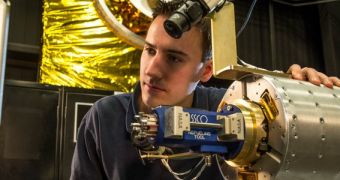A group of investigators with the Satellite Servicing Capabilities Office (SSCO) at the NASA Goddard Space Flight Center (GSFC) in Greenbelt, Maryland, announces the development of an innovative technology that could soon make propellant transfers between spacecraft a tangible reality.
The team's main goal is to enable future generations of space exploration vehicles to transfer a type of propellant called oxidizer into the tanks of satellites in orbit around Earth today. SSCO experts have just recently concluded a remotely-controlled, successful test of the new technology.
An additional set of results was obtained from the Robotic Refueling Mission experiment, which is currently installed aboard the International Space Station (ISS). This facility is currently being prepared for a number of additional experiments, scheduled to be tested in space over the next couple of years.
The RRM will eventually be used to simulate an encounter between a full-sized robotic resupply spacecraft and a satellite client in Earth's orbit. What NASA is aiming for with this type of research is to develop the ability to service some of its largest and most expensive satellites without the need to build and launch replacements.
Very often, satellites go offline due to the fact that they run out of fuel. If some way were to exist wherein fuel could be transferred into those spacecraft's tanks, then their operational life could be extended by decades. The SSCO has taken it upon itself to answer this issue directly and efficiently.
Its latest achievement was the completion of the Remote Robotic Oxidizer Transfer Test (RROxiTT) experiment, which occurred in February 2014. Technologies such as this one will come in handy for repairing and maintaining spacecraft, assembling telescopes in space, and enabling more efficient human space exploration.
“This is the first time that anyone has tested this type of technology, and we've proven that it works. It's ready for the next step to flight. RROxiTT gives NASA, and the satellite community at large, confidence that advanced satellite refueling and maintenance technologies aren't a wild dream of the future,” explains researcher Frank Cepollina.
“They're being built and tested today – and the capabilities that they can unlock can become a reality,” adds the expert, who led all five missions to repair the NASA/ESA Hubble Space Telescope. He also holds an appointment as the associate director of SSCO.
The technology RROxiTT will enable in the near future will allow resupply spacecraft to move all the way to GEO (geosynchronous Earth orbit), some 32,200 kilometers (22,000 miles) above the surface, and service the 400 critical satellites occupying this orbital porch directly.

 14 DAY TRIAL //
14 DAY TRIAL //